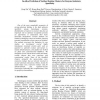Free Online Productivity Tools
i2Speak
i2Symbol
i2OCR
iTex2Img
iWeb2Print
iWeb2Shot
i2Type
iPdf2Split
iPdf2Merge
i2Bopomofo
i2Arabic
i2Style
i2Image
i2PDF
iLatex2Rtf
Sci2ools
CSB
2004
IEEE
2004
IEEE
In-Silico Prediction of Surface Residue Clusters for Enzyme-Substrate Specificity
One of the most remarkable properties of enzyme-substrate binding is the high substrate specificity among homologous enzymes. Identification of regions in enzymes that play an important role in substrate recognition presents an opportunity to understand their basic molecular mechanisms. Current methods are limited to identifying conserved residues, ignoring potential contributions of non-conserved residues. Our method overcomes this limitation. In case studies, we investigated several highly homologous enzymatic protein pairs such as guanylyl vs. adenylyl cyclases and lactate vs. malate dehydrogenases, and applied our method on plant and cyano-bacterial RuBisCos. We identified several critical mono-residue and multiresidue clusters that were consistent with experimental results. Some of the identified clusters, primarily the mono-residue ones, represent residues that are directly involved in enzyme-substrate interactions. Others, mostly the multi-residue ones, represent residues vital...
Bioinformatics | Conserved Residues | CSB 2004 | Homologous Enzymatic Protein | Homologous Enzymes |
| Added | 20 Aug 2010 |
| Updated | 20 Aug 2010 |
| Type | Conference |
| Year | 2004 |
| Where | CSB |
| Authors | Gong-Xin Yu, Byung-Hoon Park, Praveen Chandramohan, Al Geist, Nagiza F. Samatova |
Comments (0)

